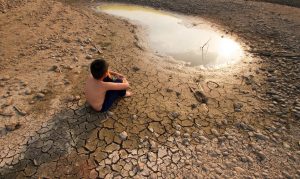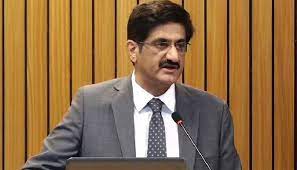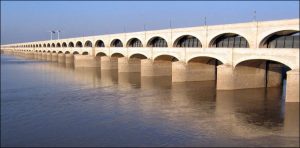KARACHI:
Pakistan’s Sindh province is facing a major water shortage. Farmers along the coastline of Badin and Thatta districts are protesting en masse as they desperately seek water to irrigate their fields. There isn’t even water there to drink.
Hundreds of thousands of acres of agricultural lands have become barren due to the acute water shortage of up to 50 per cent. As a result, Indus Delta farmers and small growers are facing serious challenges in sowing cotton, rice and sugar cane in the agricultural lands of southern Sindh.
According to the Meteorological Department, the national rainfall for the month of April 2022 was 74 per cent below normal, making it the second driest month since 1961. According to the department, upper Sindh districts are expected to remain dry, with temperatures ranging from 44°C to 47°C. These consistent hot and dry conditions increase the requirements for standing crops in the region, which are at advanced states.
Chief Meteorologist Sardar Sarfaraz said February, March and April were dry months with 60 to 70 per cent less rain than normal. Due to climate change, he said rainfall in Pakistan has decreased by almost 50 per cent. He said there is potential for good rainfall during the monsoon, which generally stretches from the end of June until September.
Farmers across Sindh province held demonstrations to emphasize the severity of the water crisis, where half a million acres of agricultural land have become barren as a result. Syed Fayaz Rashdi 52, a farmer and landowner in Badin said his district used to receive water from two barrages, Kotri and Sukkur, through its canals. But he said there hasn’t been water in Rohri Canal or Nasser canal since March.
Following orders from influential political leaders, irrigation officers have closer the doors of the canal in Tando Allahyer, he said, adding that due to the water shortage, people aren’t even able to find water to drink.
Fayaz Rashdi, president of the Sindh Abadgar Association (SAA) told The Express Tribune that he was sowing cotton on three acres of land, but due to the water shortage, his crop has been completely destroyed. He said this has resulted in financial loss worth 1.2 million PKR.
Rashdi has 40 peasant families working in his fields whom he paid 50 thousand PKR. At least 40 peasant families are working in my fields, and I paid PKR 50 thousand per family in advance for their work but now they are worried how they will survive as th ere is no work for them in this Kharif season, Fayaz said.
Ali Palh, President of Sindh Agriculture Research Council (SARC) told The Express Tribune that there was 62 per cent shortage of water in Sindh at three barrages. He said 70 per cent of cities and villages are affected by acute water shortage — not only for agricultural but also for drinking.
Acute water shortages in rest of the province have also affected mangrove orchards, cotton and vegetable production, Palh said, adding that there has been a 60 per cent decline in mango production due to high temperature between 38 and 43 centigrade, when mangoes require temperatures closer to 32 degrees. Pahl said this has caused a decline in production, which will affect the country’s exports.
He said that solar tube wells have saved his production but but most areas in Sindh do not have sweet water like his. Haq Nawaz, 57, a farmer and owner of 70 acres of land in Ali Muhammad Rind village near Thatta said there hasn’t been water in Thatta’s tail for the last 5 years. As a result, he said farmers have not sowed cotton, sugarcane and rice crops because of water shortages.
Nawaz said no resident of his villages has sown crops in this Kharif season due to shortage of water, despite there being 10,000 acres of land all around. On March 2022, Nawaz said the Sindh High Court ordered to relevant authorities to provide water to the farmers of Ali Muhammad Village, but irrigation officers are not implementing court’s orders.
Nawaz said he is living hand to mouth and selling his cattle to feed his family. Like hundreds of other small growers and farmers, he said he is facing serious economic challenges without sowing crops in Kharif season.
Sindh government’s response to water crisis
Chief Minister of Sindh Syed Murad Ali Shah agrees there is a water shortage but attributes it to the distribution of water. He said the Sindh government has serious reservations about how the situation is being handled by the Indus River System Authority (IRSA).
Shah said provinces were told there would be an eight per cent water shortage during the early part of Kharif season, and that Sindh and Punjab would face 22 per cent and 13 per cent shortages respectively. But he argues the shortage should be the same for Sindh and Punjab, as Sindh faced a 42 per cent shortage for 10 days in May, which combined with the prior shortag would bring the number to 51 per cent.
The Indus River recently had 89,800 cusecs of inflow at Tarbelaand compared to 60,400 cusecs recorded last year, Shah said. He said that last year at Kabul inflows were recorded at 41,900 and the Jhelum Inflows were 175,000 and 188,000 cusecs but he believes distribution is defective since link canals are opened in Punjab.
The Taunsa is the last barrage of Punjab and Guddu is the first barrage of Sindh, Murad Ali Shah said, adding that Taunsa’s inflow was recently recorded at 66,000 cusecs but when it reached our first barrage, Guddu, the inflow was 38,000 cusecs. “This means water was taken away before reaching to Sindh,” he said.
Fida Hussain 40, a farmer in Nawab Shah told The Express Tribune that acute water shortages have nearly destroyed bumper crops cotton and sugarcane, which are
cash crops for small growers and farmers in this area. He added that the tube well water has also badly affected crops but farmers can not even afford the cost of diesel to run the electric tube well to irrigate the crops.
Cotton crops need water once in week and four days in a month, Fida said, adding that there isn’t enough water available in Bilawal Canal and Rohri Canal for this to happen. He said that due to unfair distribution of water, big landlords can easily get water for their agricultural lands but small farmers and growers are neglected. He said Badin is badly affected by the acute water shortages in Sindh.
Water inflow and outflow from barrages in Sindh
Abdul Aziz Soomro, who is in charge of the Sukkur Barrage told The Express Tribune that Sindh is facing a 62 per cent water deficit. He said there is 115 per cent water scarcity at Guddu Barrage, 52 per cent at Sukkur Barrage and 71 per cent at Kotri Barrage, adding that due to the shortage of water in canals, farmers are facing serious challenges.
The inflow of water at Guddu Barrage is 48,619 cusecs and discharge is 46,146 cusecs at Guddu. The inflow of water is 40,605 cusecs at Sukkur Barrage and discharge was 15,555 cusecs at Sukkur Barrage. Inflow at Kotri Barrage was 5,350 cusecs and discharge was 100 cusecs, Abdul Aziz Soomro said, adding that the situation is likely to improve within coming days.
The water inflow has increased from Chashma Barrage from 91,000 to 100,000 cusecs, he said, adding that if the inflow of water increased from the Kabul River and Tarbela Dam, it will be possible to provide water for agricultural purpose to the farmers in Sindh after June 1. He attributes water shortages to climate hange and decreased rainfall in the country.
Soomro said they have released 1000 cusecs of drinking water from the Ghotki Canal and Pat Feeder Canal for Balochistan recently but agricultural water is still suspended. He also said they released water in the Dadu Canal and Rice Canal for drinking water. Soomro said the situation would improve if barrages and the Indus River released water in these canals in Sindh.
Indus River System Authority (IRSA) comments
There is an acute shortage of water in Pakistan and 90 per cent of water we received from glaciers, Zahid Hussain Junejo, Chairman of the Indus River System Authority told The Express Tribune that Pakistan is facing a 90 per cent water shortage from glariers glaciers. He said climate change has changed the country due to reduced amounts of rainfall.
He said people living on the tails of canals are facing acute water shortages but hopes that by mid June the water inflow will be better, which will allow IRSA to provide water for agricultural purposes.







